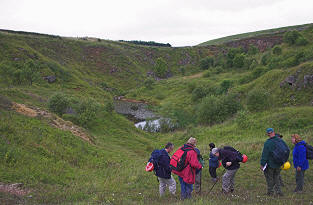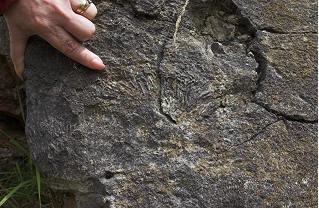|
Date: |
Sunday 14 August 2005 |
|
Location: |
Hartington, Derbyshire |
|
Leader: |
Steve ? & Bob Woolley |
|
Author: |
Glynis Sanderson |

Salad Burnet (Poterium sangusiorba) with Burnet Moth (Zygaena trifiolii) Photo © Barry Sanderson
On a nature reserve south of Buxton we gathered to look at the flora and fauna of the area and how geology has influenced what grows there. We started on an old limestone quarry spoil heap where the first flower seen was the Northern Marsh Orchid, the most southerly siting of this plant. Next to a lightly grazed limestone meadow where we found Knapweed (Centaurea nigra), Field Scabious (Knautia arnvensis), Rose Bay Willow Herb (Chamaenerion angustifolium), and Great Burnett (Sanguisorba officinalis).
Then to a higher meadow that had been grazed. 30 - 35 different flowers are know to poplulate this area, and it was certainly a riot of colour. We spotted Cowslips (Primula veris), Ladies Bedstraw (Galium verum), Betony (Betonica officinalis), Hay Rattle (Rhinanthus crista-galli), Devils Bit Scabious (Succisa pratensis), Ragwort (Senecio squalidus), Harebells (Campanula rotundifolia) and Hawkbit (Leontodon autumnalis). We tasted the Salad Burnet (Poterium sanguisorba) and then left it to the Burnet moth (Zygaena trifolii) to finish his lunch. On the top ungrazed meadow there were far fewer flowers to see. Steve explained how the levels of grazing, the resultant fertilization and mowing effected the number of flower species present.

Silica pit, formed in a hollow in a karst environment. Photo © Barry Sanderson
From the meadows we walked past a disused domestic rubbish (and other material) landfill that has been capped with clay and then had to be provided with vents to vent off the methane produced. A few wetland plants were visible. Derbyshire Wildlife Trust has only recently acquired this, with time it will be stock grazed. Approaching the sandpit we spotted Wild Angelica (Angelica sylvestris) - we could hardly miss it at six feet highh!

Coral fossil in the Bee Low Limestone. Photo © Barry Sanderson
Some members of the group the descended into the sandpit where looking at the geology took over from the flora, though we did see Grass of Parnassus (Parnassia palustris), a lover of limestone and, like the orchid seen earlier it is at its southern most limit. The pocket deposits have been preserved by the collapse of solution cavities within the limestones and dolomites. There is no agreement yet as to the timing of the solution and collapse of the limestone. Theories include during the Namurian, during the Tertiary and, the one favoured by Bob, uplift during the Alpine Orogeny. At this time the river that had originally deposited the sediments became rejuvenated cutting through the impermeable shale and allowing the water to permeate through the limestones thus creating the conditions for caverns to forma and collapse. Lunch was taken at the quarry sitting on old railway sleepers. The floor of the quarry floor was covered with Autumn Gentian (Gentianella amarella) as we walked across to look at a fault in the Bee Low Limestone. Partway over, Steve lifted an old pallet and underneath we saw a Great Crested Newt, which survives on just the rainfall on this apparent arid quarry floor. During the afternoon we walked round the walls of the quarry and saw crinoids, brachiopods and corals, as well as Mottled crickets, Carline thistles, and Cranesbill (Geranium robertianum). Thank you to Steve and Bob for a very interesting day.

Bedding in the Bee Low Limestones. Photo © Don Cameron